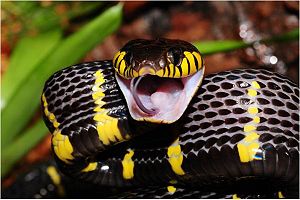Sandbox Reserved 932
From Proteopedia
(Difference between revisions)
m |
|||
| Line 25: | Line 25: | ||
===Structure=== | ===Structure=== | ||
| + | |||
Denmotoxin is a monomeric protein consisting of 77 amino acid residues. Multiple sequence alignment of denmotoxin reveals that the venom belongs to the family of non-conventional 3FTXs. Denmotoxin has 7 additional amino acid residues in its N-terminal when compared to other elapid 3FTXs; the N-terminus is also blocked by a pyroglutamic acid residue. The biological function of the pyroglutamic acid residue is currently unknown. | Denmotoxin is a monomeric protein consisting of 77 amino acid residues. Multiple sequence alignment of denmotoxin reveals that the venom belongs to the family of non-conventional 3FTXs. Denmotoxin has 7 additional amino acid residues in its N-terminal when compared to other elapid 3FTXs; the N-terminus is also blocked by a pyroglutamic acid residue. The biological function of the pyroglutamic acid residue is currently unknown. | ||
| - | There are 10 structurally important cysteine-residues in denmotoxin which form five stabilizing <scene name='57/579702/Disulphides/3'>disulphide bonds</scene>. Four of these disulphide bonds are located at the | + | There are 10 structurally important cysteine-residues in denmotoxin which form five stabilizing <scene name='57/579702/Disulphides/3'>disulphide bonds</scene>. Four of these disulphide bonds are located at the <scene name='57/579702/3ftx_beta_strands/2'>central core</scene> and the fifth at the tip of the first loop. The cysteine residues of all 3FTXs are highly conserved, whereas the other residues within the sequence express high variability. Denmotoxins consists of <scene name='57/579702/Three_fingers/1'>three polypeptide loops</scene> protruding from the globular core; this structure is typical for 3FTXs. The globular core consists of a triple stranded anti-parallel β-sheet; two of the β-strands in this structure connect to the second loop (central loop) and one β-strand connects to the third loop. There are two highly <scene name='57/579702/Flexible_regions/2'>flexible regions</scene> on the protein: one at the tip of the central loop and one at the 3 first residues of the N-terminus; the expected active site of denmotoxin is at the tip of the central loop. |
Denmotoxin shares approximately 30% sequence similarity with other 3FTXs with an exception of exhibiting approximately 50% sequence similarity with another colubrid snake venom α-colubritoxin. Despite the relatively low sequence similarity, denmotoxin possesses all the residues needed to maintain the 3 finger fold. A large part of the sequence similarity between denmotoxin and other 3FTXs is due to the highly conserved disulphides and a number of structurally important residues. | Denmotoxin shares approximately 30% sequence similarity with other 3FTXs with an exception of exhibiting approximately 50% sequence similarity with another colubrid snake venom α-colubritoxin. Despite the relatively low sequence similarity, denmotoxin possesses all the residues needed to maintain the 3 finger fold. A large part of the sequence similarity between denmotoxin and other 3FTXs is due to the highly conserved disulphides and a number of structurally important residues. | ||
Revision as of 12:13, 15 May 2014
| This Sandbox is Reserved from 01/04/2014, through 30/06/2014 for use in the course "510042. Protein structure, function and folding" taught by Prof Adrian Goldman, Tommi Kajander, Taru Meri, Konstantin Kogan and Juho Kellosalo at the University of Helsinki. This reservation includes Sandbox Reserved 923 through Sandbox Reserved 947. |
To get started:
More help: Help:Editing |
B. Dendrophila monomeric toxin (Denmotoxin) is the primary protein of snake venom used by Boiga dendrophila. This colubrid snake lives in Southest Asian lowland rainforest and mangrove swamps using birds as its primary prey.
One of the most well characterized snake venom protein families is the Three-finger-toxins (3FTX). These proteins have three β-stranded finger-like loops, stabilized by four disulphide bridges on the surface of a globular core. In non-convential 3TFXs a fifth disulphide bridge can be present as is the case in Denmotoxin.
How the overall structure looks like? Subunits orientation, chains: the number and relative positions, etc.
Denmotoxin
| |||||||||||

![Three fingers formed by three peptide loops (F1, F2 & F3) [PDB=2H5F]](/wiki/images/thumb/3/3f/Kolme_sormea_figure_text.png/300px-Kolme_sormea_figure_text.png)
